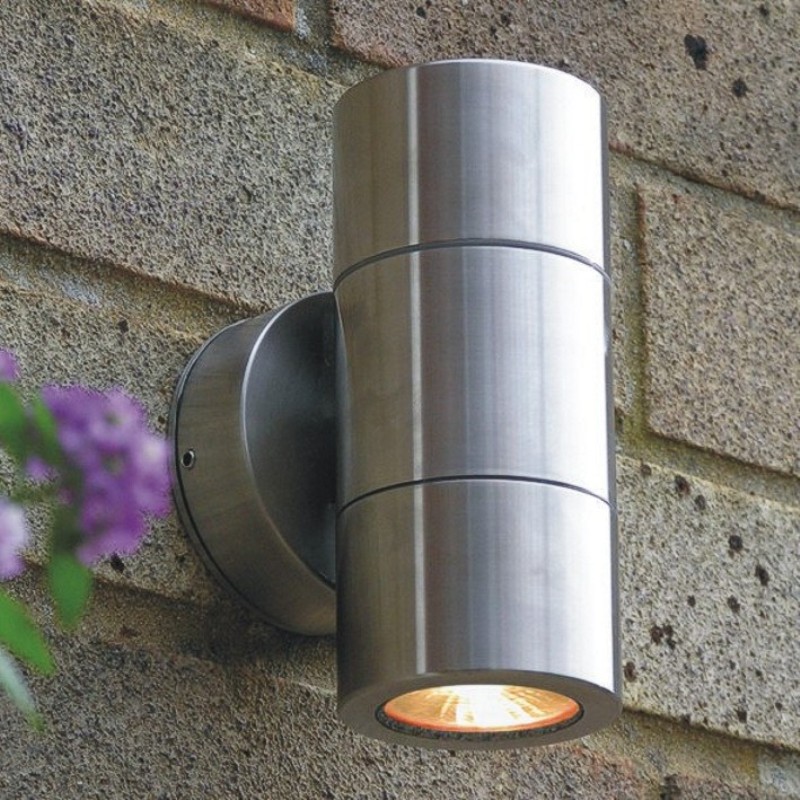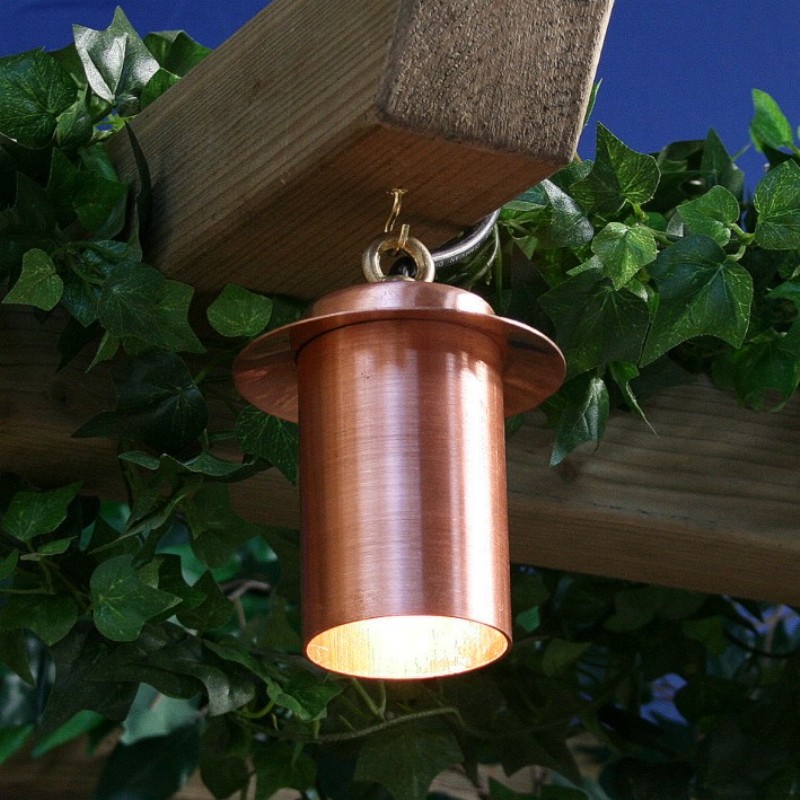Uplighting is the most commonly used garden lighting technique, for shrub borders and trees especially. By uplighting trees, one exploits a unique opportunity to add vertical emphasis and drama. Trees with an open habit allow light to fully display the branch structure, while the contrast of colour between subjects can be emphasised. The light coloured bark of a silver birch, the coppery stems of Prunus serrula, the golden fern-like foliage of Gleditsia triacanthos "Sunburst" or the translucent fiery leaves of Acer palmatum "Crimson King" are examples of good lighting subjects. For trees with dense canopies and darker foliage, uplighting rarely works well on its own. Uplighting through the central branch structure and crosslighting the canopy from a second source is one alternative; really dense canopies, such as conifers, can only be lit from outside. Where there are several trees in a view, avoid lighting them uniformly (unless you are lighting an avenue). Light some from the front and others from the side to provide contrast. Lighting a house wall to silhouette a tree in front is an interesting effect if the tree has an open structure. Alternatively a spotlight in front can project the shadow of a tree onto the wall behind, a good way of using a small acer to create a big effect in a newly planted garden.
Trees can be good lighting platforms in relation to shrub borders, as well as a way of lighting terraces, driveways, paths, steps and seating areas. A favourite technique is "moonlighting" down from low power lights fixed in a tree to shadow the lower branches and foliage onto the ground below. This provides a wonderfully subtle, dappled lighting effect over a tree seat and is also a creative way of integrating the lawn into the lighting scene or lighting a path or drive in a rural garden. For moonlighting, or if you are spotlighting a feature from a tree or uplighting a tree canopy above a tree seat, use Elipta Compact tree mount spotlights to mount a tree spotlight with rustic brown powder-coat finish which blends well with tree bark. You may like to experiment with a pale blue "moonlighting" filter to provide the cool light of the moon instead of the more golden light of an unfiltered halogen lamp. The strap-on tree mount comes with a choice of 5 lengths of mounting strap as the kindest way to fix small lights to a tree without screws. Hanging lights can also be used in smaller trees to provide pools of light and decorative sparkle over a patio area. Low wattage 20w - 35w lamps with wide beam angles are generally best for moonlighting unless you need brighter lighting for a particular reason.
The Elipta COMPACT spike spotlight is one of the best low voltage spike spotlights for uplighting smaller trees and comes in a variety of materials and finishes including rustic brown finish which blends into woody settings. Designed for 50w halogen lamps, the Elipta COMPACT spike spotlights now also accommodate the new generation of POWERSAVER energy-saving halogen lamps, which provide 50% more light than a conventional halogen reflector lamp for the same power consumption – so a COMPACT spotlight with a POWERSAVER 50w lamp now does the same job as a larger 75w halogen spotlight used to do. A general purpose low voltage or mains voltage recessed uplight, the MODULA range, also features a 50w model which accepts POWERSAVER lamps for uplighting small trees - remember to use cooler led lamps in walkover areas as the lenses can get very hot with these halogen lamp wattages. Try to "fit" the lamp beam to the tree shape to avoid wastage of light and energy by studying the lamp beam diameter and the pool of light it provides at a given distance. To uplight small to medium size trees, use one or more tungsten halogen or POWERSAVER lamps of 50 watts and a beam angle to suit the tree - 24 degrees for a slender silver birch, 60 degrees for a weeping tree and 36 degrees for most tree shapes in between.
Help and Tips provides useful helpsheets on subjects such as choosing the right lamps for your spotlights and uplighting trees.
Uplighting for larger trees generally means moving to mains voltage uplights using metal halide light sources. These are high-efficiency white light sources with controlled beams for effective uplighting while avoiding excessive light pollution if used properly.
Uplighting trees with metal halide uplights is energy efficient and more controlled than with floodlights, which provide a less focused beam than a spotlight: good garden lighting design is about controlled use of lighting, not indiscriminate lighting up of the night sky. Uplighting with an energy-saving metal halide spike- or surface-mount uplight such as APOLLO or the recessed adjustable PERSIUS and Olympus uplights is still the preferred technique where the openness of the canopy and branch structure allow the light beam to penetrate up through the tree. Metal halide uplights can be placed close to the outer edge of the canopy of densely-foliated trees such as conifers, “grazing” the foliage to emphasise texture from a close position.
Elipta’s 240v APOLLO range has a choice of reflector beam angles to project a 36 or 60 degree beam upwards to light the inner structure of a tree, a dense tree canopy or a building facade. The Apollo 70w and 150w are designed for uplighting the largest trees. Apollo35 is a compact option for energy efficient uplighting of smaller, darker trees and 2-storey facades. These are all surface-mount uplights with adjustable stirrup bracket for mounting on walls or an optional ground spike. All metal halide uplights are 240v energy-saving floodlights, typically providing an energy saving of at least 80% compared with ordinary halogen floodlights
Elipta’s 240v OLYMPUS range has a choice of reflector beam angles to project a 36 or 60 degree beam upwards to light the inner structure of a tree, a dense tree canopy or a building facade. They are available in 70w and 150w models designed for uplighting the largest trees. PERSIUS is a compact 35 watt option for energy efficient uplighting of smaller, darker trees and 2-storey facades. These are all recessed uplights with adjustable internal reflectors in a choice of beam angles to suit spreading canopies, fan shaped trees and columnar specimens. All metal halide uplights are 240v energy-saving lights, typically providing an energy saving of at least 80% compared with ordinary halogen floodlights. Both ranges incorporate twin-compartment, twin lens construction, so that the hot lamp and control gear is in a lower compartment and a second upper compartment acts as an insulating chamber to ensure a cool lens temperature suitable for use in most walkover areas. Both OLYMPUS and PERSIUS uplights are available with a choice of 316 stainless steel top ring, a textured brass ring for buff stone and heritage settings, green top for installation in lawns, or black ring where the most discreet recessive finish is required




12 volt halogen floodlights are designed for lighting smaller feature areas, such as planting groups and hedges, with a broad swathe of light and for providing infill or background lighting to complement the accent lighting of individual garden features. The Elipta MICROFLOOD DUO is finished in rustic brown powder-coated aluminium, which can be discreetly tucked behind planting: it is also easy to integrate with other 12v wiring in a mixed lighting setting to uplight spreading features such as small willows or wisteria. Microflood Duo is a twin 50w halogen spike mount floodlight providing two adjustable wide flat beams which can be overlapped to provide vertical coverage of small trees with dense canopies or tall hedge screens such as Leylandii